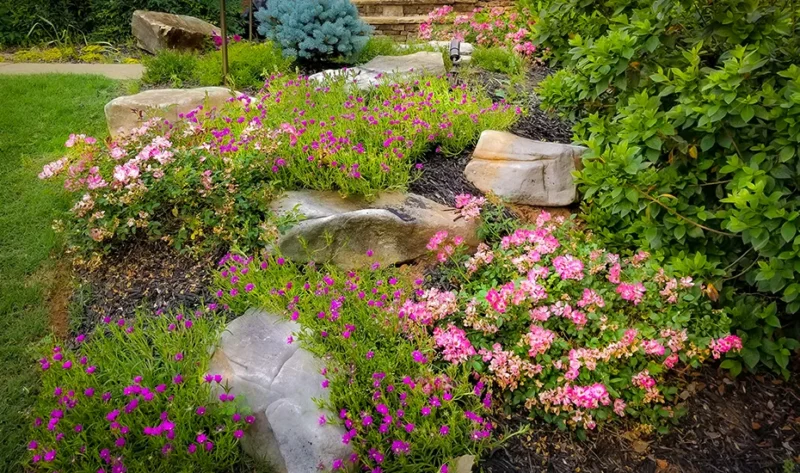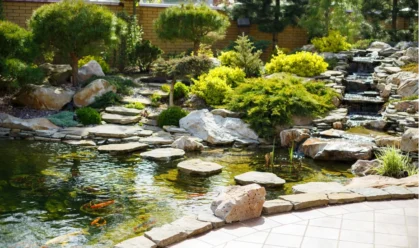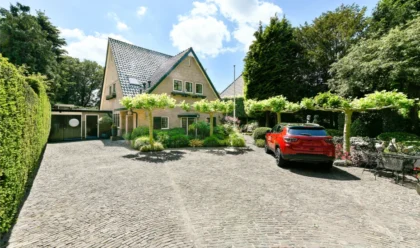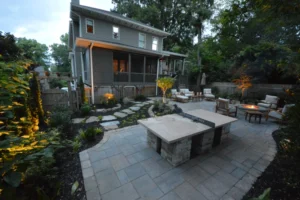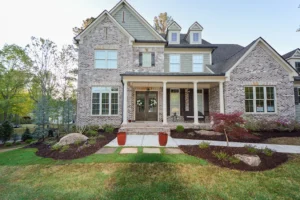You’ve worked your fingers to the bone to make your landscape or outdoor space spectacular. So why let all that hard work disappear when the sun goes down? Outdoor lighting is essential. With some trendy landscape lighting ideas, you can ensure that your landscape and its features remain visible long after dark.
This post will guide you through the seven most important considerations to reflect on before installing outdoor lighting.
1. Define Your Goals and Needs
Before selecting lighting fixtures, it’s crucial to define your objectives for outdoor lighting. Luxury homeowners often have multifaceted goals, including:
-
- Aesthetics:
Determine which architectural features, garden elements, or water features you want to highlight. For example, uplighting can accentuate the grandeur of columns or trees, while downlighting can create a soft glow on walkways.
-
- Functionality:
Assess how you use your outdoor spaces. If you frequently host gatherings, consider lighting for dining areas, seating arrangements, and pathways. If security is a priority, ensure that areas around entrances and driveways are well-lit.
-
- Ambiance:
Think about the mood you want to create. Soft, warm lights can create a cozy, intimate atmosphere, while bright, focused lights can energize and invigorate your outdoor spaces.
Clearly defining these goals will guide your decisions and help create a cohesive lighting design that enhances your property’s beauty and utility.
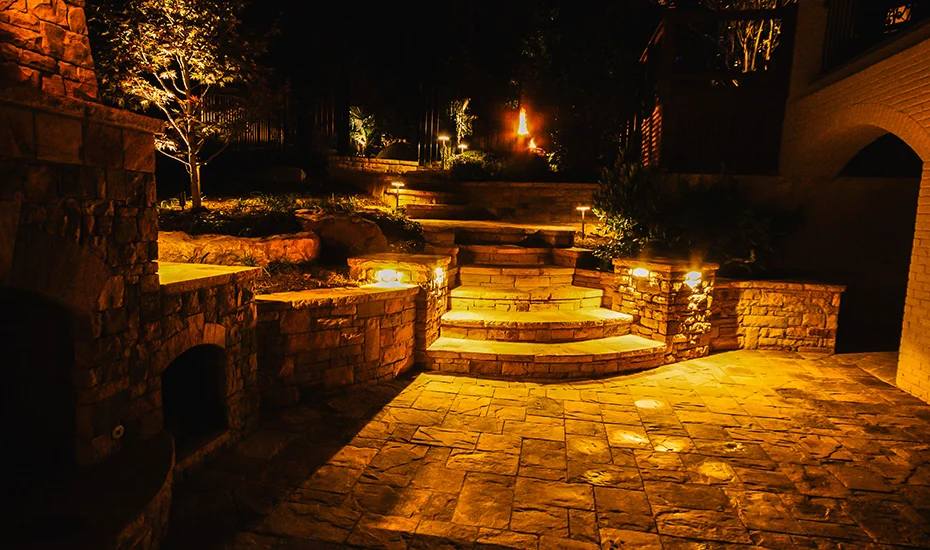
2. Choose the Right Lighting Fixtures
The choice of lighting fixtures is pivotal in achieving your desired effect. Here’s what to consider:
- Types of Fixtures:
Different fixtures serve different purposes:-
- Path Lights:
Ideal for illuminating walkways and driveways.
-
- Spotlights:
Used to highlight specific features like statues or trees.
-
- Floodlights:
Provide broad illumination, ideal for security and large areas.
-
- Wall Sconces:
Enhance the walls of your home and create a stylish look.
-
- Pendant Lights:
Perfect for outdoor dining areas or covered patios.
-
- Material and Finish:
- Smart Lighting:
LEDs are famous for their energy efficiency and long lifespan. Solar-powered lights are another eco-friendly option, though they may be less bright. Integration with home automation systems allows you to control lighting remotely, adjust brightness, and create custom lighting schedules.
Selecting the right fixtures ensures you achieve functional and aesthetic goals while aligning with your home’s style.
3. Consider Lighting Placement and Layout
Strategic placement and layout of lighting fixtures are essential for achieving balanced and effective illumination:
-
- Strategic Placement:
Lights should be placed strategically to highlight key features and avoid creating harsh shadows. For instance, placing lights at the base of trees or sculptures can enhance their visual impact.
-
- Layering Light:
Combine ambient (general), task (functional), and accent (decorative) lighting to create a layered effect. For example, combine path lights with wall sconces and spotlights for a well-rounded approach.
-
- Landscape Integration:
Ensure lighting complements the landscaping elements, such as gardens and water features. Well-placed lights can enhance the natural beauty of your outdoor spaces.
-
- Avoiding Light Pollution:
Be mindful of light spillover affecting neighboring properties. Use shields and directional fixtures to minimize glare and light pollution.
A well-thought-out placement and layout will enhance both the beauty and functionality of your outdoor lighting.

4. Evaluate Electrical Requirements and Safety
Proper electrical planning and safety are critical for a successful outdoor lighting installation:
-
- Power Supply:
Assess your current electrical system to determine if it can handle the additional load of new lighting fixtures. You may need to upgrade your system or add dedicated circuits.
-
- Professional Installation:
Hiring a licensed electrician ensures the installation complies with safety standards and local building codes. Professionals will also ensure that the wiring is weatherproof and correctly installed.
-
- Safety Measures:
Choose fixtures rated for outdoor use and designed to withstand the elements. Proper wiring and connections are essential to prevent electrical hazards and ensure long-term performance.
Addressing these electrical and safety considerations will protect your investment and ensure a reliable lighting system.
5. Budget and Cost Considerations
| Fixture Type | Estimated Cost |
|---|---|
| Solar-powered lights | $20 – $100 |
| Pathway lights | $50 – $200 |
| Floodlights | $100 – $300 |
| Security lights | $150 – $400 |
| String lights | $20 – $100 per string |
| Post lanterns | $150 – $400 |
| Wall sconces | $100 – $300 |
Budgeting for outdoor lighting involves several factors:
-
- Initial Costs:
Include the cost of fixtures, installation, and any necessary electrical upgrades. High-quality fixtures and professional installation may involve a significant initial investment.
-
- Maintenance Costs:
Consider ongoing bulb replacements, cleaning, and repair expenses. Energy-efficient options like LEDs can reduce long-term costs.
-
- Value Addition:
Quality outdoor lighting can enhance your property’s value and curb appeal. Well-designed lighting can make your home more attractive to potential buyers.
Careful budgeting will help you balance initial costs with long-term benefits and ensure that you make a worthwhile investment.

6. Environmental Impact and Sustainability
Sustainability is an essential consideration for many luxury homeowners:
-
- Eco-Friendly Options:
Choose solar-powered or energy-efficient LEDs to minimize your carbon footprint. These options are both environmentally friendly and cost-effective.
-
- Landscape Preservation:
Select fixtures and installation methods that minimize disruption to natural habitats and ecosystems. Avoiding excessive light spillover can also protect local wildlife.
-
- Regulatory Compliance:
Ensure that your lighting installation adheres to local regulations and guidelines, which may include restrictions on light pollution and energy consumption.

By prioritizing sustainability, you can create a beautiful outdoor environment while minimizing your impact on the planet.
7. Seasonal and Functional Flexibility
Outdoor lighting should be adaptable to different seasons and functions:
-
- Adaptability:
Choose fixtures and designs that remain effective throughout the year. For example, weather-resistant fixtures are essential for enduring various weather conditions.
-
- Seasonal Adjustments:
Plan for changes in daylight and weather. Adjust the lighting for different seasons or add festive decorations during holidays.
-
- Future-Proofing:
Opt for modular and upgradeable lighting systems that can be easily modified or expanded. This flexibility ensures that your lighting setup remains relevant and effective over time.
These factors will help you create a versatile and enduring outdoor lighting design.
| Feature | Solar-Powered Lights | Pathway Lights | Floodlights | Security Lights | String Lights | Post Lanterns | Wall Sconces |
|---|---|---|---|---|---|---|---|
| Power Source | Solar panels | Electrical grid | Electrical grid | Electrical grid | Electrical grid | Electrical grid | Electrical grid |
| Installation | Easy, minimal wiring | Moderate, requires wiring | Moderate, requires wiring and mounting | Moderate, requires wiring and mounting | Easy, minimal wiring | Moderate, requires wiring and mounting | Moderate, requires wiring and mounting |
| Maintenance | Low, battery replacement | Low, bulb replacement | Low, bulb replacement | Low, bulb replacement | Low, bulb replacement | Low, bulb replacement | Low, bulb replacement |
| Cost | Higher upfront, lower long-term | Moderate upfront, moderate long-term | Higher upfront, moderate long-term | Higher upfront, moderate long-term | Lower upfront, lower long-term | Higher upfront, moderate long-term | Higher upfront, moderate long-term |
| Brightness | Varies, typically lower | Moderate | High | High | Moderate | Moderate | Moderate |
| Versatility | Limited, ideal for pathways and accent lighting | Ideal for pathways and walkways | Ideal for illuminating large areas | Ideal for security and deterring crime | Versatile, can be used for various purposes | Versatile, can be used for various purposes | Versatile, can be used for various purposes |
| Aesthetics | Modern, sleek design | Classic, traditional design | Functional, utilitarian design | Functional, utilitarian design | Decorative, festive design | Classic, traditional design | Elegant, decorative design |
| Environmental Impact | Eco-friendly, no electricity consumption | Moderate, consumes electricity | High, consumes electricity | High, consumes electricity | Moderate, consumes electricity | Moderate, consumes electricity | Moderate, consumes electricity |
A comprehensive table focusing specifically on the types of lighting used in landscaping.

Conclusion
Choosing the right outdoor lighting is a game-changer for luxury homeowners looking to enhance their property’s beauty, functionality, and security.
With thoughtful planning and expertise, you can transform your outdoor spaces into a captivating extension of your home, visible and inviting long after the sun goes down. Ready to bring your vision to life? Contact a professional to start your outdoor lighting project and illuminate your property with style and sophistication.













